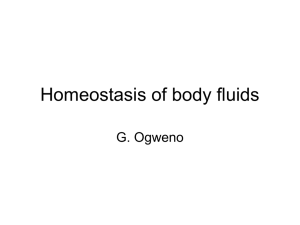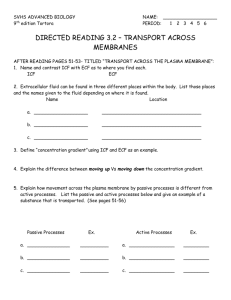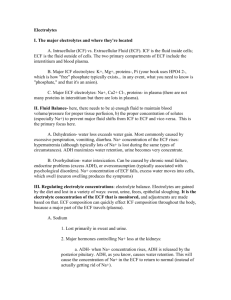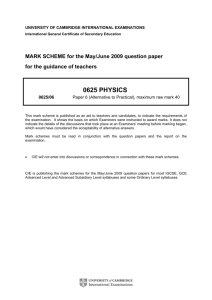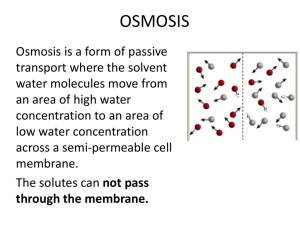Chapter 26 Balance
advertisement
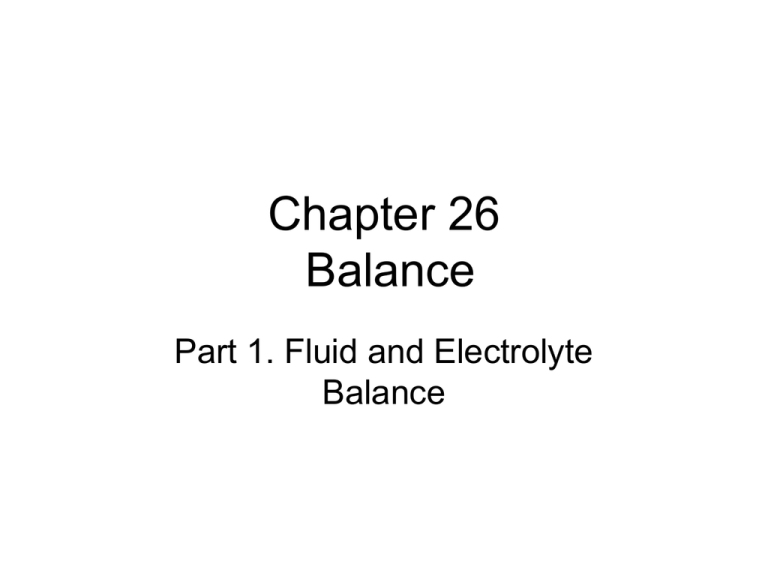
Chapter 26 Balance Part 1. Fluid and Electrolyte Balance Fluid, Electrolyte, and Acid–Base Balance • The body must maintain normal volume and composition of the extracellular fluid (ECF) and the intracellular fluid (ICF) Fluid Balance • Daily balance between amount of water gained and amount of water lost to environment • Maintenance of normal fluid balance involves regulating content and distribution of body water in ECF and ICF • Primary sources of water gains? D,E,M • Primary sources of water loss? L,U,S Electrolyte Balance • Balances gains and losses of all electrolytes (ions) • Primarily involves balancing rates of absorption across digestive tract with rates of loss at kidneys and sweat glands Acid–Base Balance • Precisely balances production and loss of hydrogen ions (pH) • The body generates acids during normal metabolism, tends to reduce pH • Kidneys: – Secrete hydrogen ions into urine – Generate buffers that enter bloodstream in distal segments of distal convoluted tubule (DCT) and collecting system • Lungs: affect pH balance through elimination of carbon dioxide Water • • • • 60% percent of male body weight 50% percent of female body weight Mostly in the intracellular fluid Water exchange between ICF and ECF occurs across cell membranes by osmosis • Why this difference between males and females? • In old age, only about 45% of body weight is water ECF and ICF • Water occupies two main fluid compartments • ICF = fluid inside all cells throughout body – About 2/3 by volume – Not a uniform body – water content varies greatly from fat to muscle • ECF = fluid outside cells – Mostly made up of Interstitial fluid of peripheral tissues and plasma of circulating blood Composition of the Human Body Figure 27–1a Fluid Compartments • ECF and ICF are called fluid compartments because : – they behave as distinct entities – they are separated by semipermeable membranes and have distinct compositions due to active transport (e.g. Na+/K+ pump) • A small amount of water generated inside cells moves out to the ECF all the time ICF anc ECF • ICF is relatively isolated inside cells all over the body, fluid does not mix • ECF fluids exchange constituents all the time – Occurs primarily across endothelial lining of capillaries from plasma to interstitial fluid – Fluid moves from interstitial spaces to plasma through lymphatic vessels that drain into the venous system Main Cations and Anions • In ECF: – Cations: sodium – Anions: chloride, bicarbonate • In ICF: – Cations: potassium – Anions: phosphate ions, negatively charged proteins • Sodium and potassium concentrations in extraand intracellular fluids are nearly opposites • Electrolytes determine the chemical and physical reactions of fluids Osmotic Concentrations • The osmotic concentration of ICF and ECF Is identical even though the composition of the ICF and ECF are different • Osmosis eliminates minor differences in concentration because cell membranes are permeable to water • Two-way water flow is substantial • Compartmental exchange is regulated by osmotic and hydrostatic pressures Cations and Anions in Body Fluids Figure 27–2 (1 of 2) Principles of Fluid and Electrolyte Regulation 1. All of the body’s homeostatic mechanisms that monitor and adjust body fluid composition respond to changes in the ECF, not in the ICF 2. No receptors directly monitor fluid or electrolyte balance (only volume and osmolarity) 3. Cells cannot move water molecules by active transport 4. The body’s water or electrolyte content will rise if dietary gains exceed environmental losses, and will fall if losses exceed gains Fluid Balance • Water circulates freely in ECF compartment • ECF and ICF are normally in osmotic equilibrium and no large-scale circulation occurs between compartments • If abnormal amounts of water move from plasma into interstitial fluid called? • Increases in plasma osmolality trigger thirst and release of antidiuretic hormone (ADH) Primary Regulatory Hormones • Affect fluid and electrolyte balance: 1. antidiuretic hormone (ADH) 2. aldosterone 3. natriuretic peptides Antidiuretic Hormone (ADH) • Stimulates water conservation at kidneys: – reducing urinary water loss – concentrating urine • Stimulates thirst center: – promoting fluid intake ADH Production • Osmoreceptors in hypothalamus monitor osmotic concentration of ECF (plasma, CSF) • Change in osmotic concentration in plasma and CSF alters osmoreceptor activity • Osmoreceptor neurons secrete ADH in proportion to osmotic concentraiton via the posterior pituitary Aldosterone • Is secreted by adrenal cortex in response to: – rising K+ (sensed at the adrenal cortex) or falling Na+ levels in blood – activation of renin–angiotensin system (usually due to changes in blood volume) • Determines rate of Na+ absorption and K+ loss along DCT and collecting system • “Water Follows Salt” – High plasma aldosterone concentration causes kidneys to conserve salt – Conservation of Na+ by aldosterone also stimulates water retention Aldosterone Figure 26.8 Natriuretic Peptides • ANP and BNP are released by cardiac muscle cells in response to abnormal stretching of heart walls due to elevated blood pressure or volume – Reduce thirst – Block release of ADH and aldosterone – Cause diuresis – Lower blood pressure and plasma volume Fluid Balance and Electrolyte Balance • When the body loses water: – plasma volume decreases – electrolyte concentrations rise • When the body gains or loses electrolytes: – water is gained or lost by osmosis • So fluid and electrolyte balance are intimately related, but the effects and the regulatory mechanisms are different Fluid Gains and Losses Figure 27–3 Water Balance Table 27–1 Water Losses • To remain properly hydrated, water intake must equal water output • Water gain (per day): 2.5L – 1L from food – 1.2L from water – 300 ml from metabolic water • Water loss (per day): 2.5L – 1.2L in urine – 750ml in skin perspiration (sensible and insensible) Fluid Shifts • Rapid water movements between ECF and ICF in response to an osmotic gradient • If ECF osmotic concentration increases: – ECF becomes hypertonic to ICF – water moves from inside cells to ECF • If ECF osmotic concentration decreases: – ECF becomes hypotonic to ICF – water moves from ECF into cells • ICF volume is much greater than ECF volume (clinically they say about 2/3 to 1/3): – ICF acts as water reserve – prevents large osmotic changes in ECF Water Losses • Dehydration develops when water losses exceed water gains • If water is lost, but electrolytes retained: – ECF osmotic concentration rises – water moves from ICF to ECF in a fluid shift – Both ECF and ICF will be slightly more concentrated than before but they will be osmotically balanced – net change in ECF is small – homeostatic responses will occur to replace lost water Normal Osmolarity = Osmolarity = 14 particles/10 water 14 particles/10 water ECF ICF Water Loss Osmolarity = Osmolarity = 14 particles/6 water 14 particles/10 water ECF ICF Response to Water Loss Osmolarity = Osmolarity = 14 particles/ 8 water 14 particles/ 8 water ECF Water ICF Result Osmolarity = Osmolarity = 14 particles/ 8 water 14 particles/ 8 water Osmotic balance, but at higher concentrations, lower volumes (less water) ECF Original Osmolarity = 14 particles/10 water ICF Water Losses • If water is lost, but electrolytes retained, ECF (and ICF) have higher concentrations, lower volumes • hypothalamus senses elevated ECF osmolarity this and releases ADH to restore fluid balance • New water in the ECF will shift into ICF and restore volumes and concentrations Severe Water Loss • Causes: – excessive perspiration – inadequate water consumption – repeated vomiting – diarrhea • Homeostatic responses: – physiologic mechanisms (ADH and renin secretion) – behavioral changes (increasing fluid intake) Water Gains • If water is gained, but electrolytes are not: – ECF volume increases – ECF becomes hypotonic to ICF – fluid shifts from ECF to ICF – Basically the opposite of water loss: • Reach osmotic balance but at lower concentrations, higher volumes – may result in overrhydration: • distorts cells • changes solute concentrations around enzymes • disrupts normal cell functions Water Gains • If water is gained, but electrolytes are not: • ECF is at lower concentration, higher volume • This triggers decrease in ADH release, fluid is lost and ICF will lose some water back to ECF, restoring both volume and concentration balance Causes of Overhydration • Ingestion of large volume of fresh water • Injection into bloodstream of hypotonic solution • Endocrine disorders like excessive ADH production • Inability to eliminate excess water in urine: – chronic renal failure – heart failure – cirrhosis Disorders of Water Balance: Figure 26.7a Electrolyte Balance • Requires equal rates of gain and loss for each electrolyte in the body • Electrolyte concentration directly affects water balance • Concentrations of individual electrolytes affect cell functions Na+, K+ • Sodium holds a central position in fluid and electrolyte balance • Sodium is the dominant cation in ECF • Sodium salts provide 90-95% of ECF osmolarity (concentration): – sodium chloride (NaCl) – sodium bicarbonate • Sodium concentration in the ECF normally remains stable • Potassium Is the dominant cation in ICF Rules of Electrolyte Balance • • • Most common problems with electrolyte balance are caused by imbalance between gains and losses of sodium ions Problems with potassium balance are less common, but more dangerous than sodium imbalance Changes in plasma sodium levels affect: – – • Plasma volume, blood pressure ICF and interstitial fluid volumes Renal acid-base control mechanisms are coupled to sodium ion transport Sodium Balance in ECF 1. Sodium ions taken up across digestive epithelium 2. Sodium ions excreted in urine and perspiration • If gains exceed losses, ECF content of sodium rises • If losses exceed gains, ECF content of sodium declines + Regulation of Na Concentrations in Body Fluids • Changes in ECF Na+ content do not produce lasting changes in concentration because corresponding water gain or loss due to osmosis across the digestive tract keeps concentration pretty constant (water follows salt) • So, volume and composition (total amount) of ECF may change, but osmotic concentrations may not. • Even if they do (say you eat a ton of salt without water), homeostatic mechanisms will correct this quickly + Na Balance and ECF Volume • Na+ regulatory mechanism allows changes in ECF volume but keeps concentration stable • When Na+ losses exceed gains: ECF volume will decrease due to increased water loss to the ICF in a fluid shift or through excretion, maintaining osmotic concentration • When gains exceed losses: ECF volume increases due to increased water gain or to fluid shift from ICF. • Fluid shifts WILL change the concentration a little, but ADH will quickly cause changes in water absorption to correct this Na+ Regulation So changes in sodium concentration are corrected by ADH (not aldosterone) Figure 27–4 Large Changes in ECF Volume • Large changes in ECF volume are most often due to sodium imbalances • Rarely is there a large increase or decrease in blood volume with no sodium increase or decrease – High blood volume/pressure = high sodium (and water) – Low blood volume/pressure often due to low sodium and water • Corrected by homeostatic mechanisms that regulate blood volume and pressure • If ECF volume rises, blood volume rises • If ECF volume drops, blood volume drops ECF Volume Increase • If plasma volume is too large, venous return increases stimulating heart release natriuretic peptides (ANP and BNP) • reducing thirst • blocking secretion of AII (ADH and aldosterone) • Barroreceptors trigger glomerular filtration rate to rise by pressure diuresis: • Sympathetic nervous system impulses to the kidneys decline • Afferent arterioles dilate • All of this causes sodium and water loss at kidneys increases • ECF volume declines Fluid Volume Regulation + and Na Concentrations – High Volume Figure 27–5 (1 of 2) ECF Volume decrease • If plasma volume is inadequate: – blood volume and blood pressure decline – renin–angiotensin system is activated – water and Na+ losses are reduced by ADH and aldosterone – ECF volume increases Fluid Volume Regulation + and Na Concentrations – Low Volume Figure 27–5 (2 of 2) Volume changes • So changes in ECF/blood volume are corrected by both ADH and aldosterone • Changes in sodium concentration or small changes in water balance are corrected by ADH only Homeostatic Mechanism • Baroreceptors at carotid sinus, aortic sinus, and right atrium monitor ECF volume indirectly by monitoring blood pressure + Abnormal Na Concentrations in ECF • Hyponatremia: – usu. body water content rises (overhydration) • Hypernatremia: – usu. body water content declines (dehydration) • Severe problems with electrolyte concentrations almost always occur secondary to fluid balance problems Potassium Balance • 98% of potassium in the human body is in ICF • Cells expend energy to recover potassium ions diffused from cytoplasm into ECF • Factors – Rate of gain across digestive epithelium – Rate of loss into urine, regulated along distal portions of nephron and collecting system as Na+ from tubular fluid is exchanged for K+ in peritubular fluid Factors in Tubular Secretion of K + 1. Changes in concentration of ECF: – higher ECF concentration increases rate of secretion (just because there’s more of it) 2. Aldosterone levels affect K+ loss in urine – ion pumps reabsorb Na+ from filtrate in exchange for K+ from peritubular fluid – High K+ plasma concentrations stimulate aldosterone release, lower K+ but Na+ stays 3. Changes in pH: – low ECF pH lowers peritubular fluid pH – H+ rather than K+ is exchanged for Na+ in tubular fluid so ECF K+ increases KEY CONCEPT • Fluid balance and electrolyte balance are interrelated • Small water gains or losses temporarily affect electrolyte concentrations • Effects are reduced by: – fluid shifts between ECF and ICF – hormonal responses that adjust water intake and excretion (ADH) • Electrolyte gains or losses may temporarily change solute concentration or fluid volume • Changes are opposed by: – fluid shifts – adjustments in rates of ion absorption and secretion (aldosterone) – adjustments to rates of water gain and loss (ADH and aldosterone)

